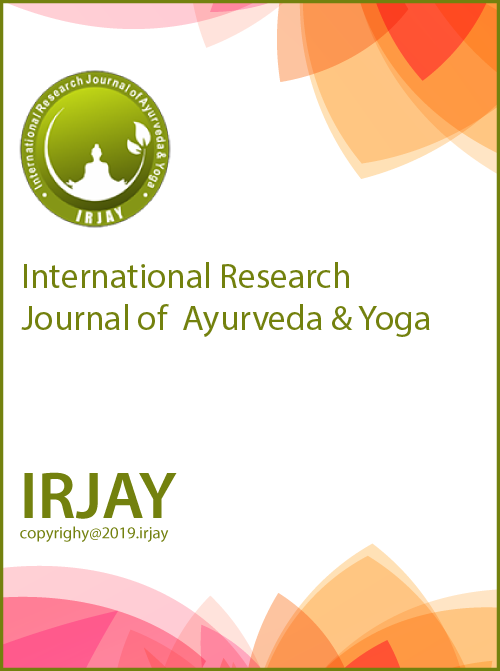Pharmaceutico – Evaluation of Pathyadi Varti Anjana Containing Moringa Oleifera Seeds: An Analytical Perspective
DOI:
https://doi.org/10.48165/IRJAY.2025.80504Keywords:
Anjana,, Cataract, High-performance thin layer chromatography, Pathyadi Varti, PhytochemicalAbstract
Background: Blur vision, particularly due to cataracts, remains a significant global public health concern, especially in rural and underserved populations. Ayurvedic formulations such as Pathyadi Varti (PV), which comprises four potent herbo-mineral ingredients with psycho-physical Kaphahara properties, have shown promise in addressing age-related ocular degeneration. This study evaluates the physicochemical properties, organoleptic characteristics, and phytochemical composition of PV.
Downloads
References
1. Scott AW, Bressler NM, Ffolkes S, Wittenborn JS, Jorkasky J. Public attitudes about eye and vision health. JAMA Ophthalmol. 2016;134(10):1111-8. doi: 10.1001/jamaophthalmol.2016.2627
2. Wolde Kentayiso T, Alto AA, Abebaw Z, Misker D, Boynito WG. Cataract prevalence and its associated factors among adult people aged 40 years and above in south Ari district, southern Ethiopia. Adv Public Health. 2023;2023:1996608. doi: 10.1155/2023/1996608
3. Singh S, Pardhan S, Kulothungan V, Swaminathan G, Ravichandran JS, Ganesan S, Sharma T, Raman R. The prevalence and risk factors for cataract in rural and urban India. Indian J Ophthalmol. 2019;67(4):477-83. doi: 10.4103/ijo.IJO-1127-17
4. Sharma S. In: Kashinath Shastri P, editor. Rasa tarangini. 8th ed., Sloka no. 73-5. New Delhi: Motilal Banarasidas Publication; 2014. p. 534. 5. Sharma S. In: Kashinath Shastri P, editor. Rasa tarangini. 8th ed., Sloka no. 106-7. New Delhi: Motilal Banarasidas Publication; 2014. p. 540.
6. Anonymous. The ayurvedic pharmacopoeia of India (Formulations). 1st ed., Vol. 2-3., Part 2. New Delhi: Government of India, Ministry of Health and Family Welfare, The Controller of Publications; 2010. p. 104, 116, 159-180, 263.
7. Anonymous. The ayurvedic pharmacopoeia of India, Appendix-3, (3.3). 1st ed., Vol. 1., Part 2. New Delhi: Government of India,
Ministry of Health and Family Welfare; 2007. p. 191.
8. Anonymous. The Ayurvedic Pharmacopoeia of India, Appendix-2 (2.2.10). 1st ed., Vol. 1., Part 2. New Delhi: Government of India, Ministry of Health and Family Welfare; 2007. p. 141.
9. Anonymous. The ayurvedic pharmacopoeia of India, Appendix-2 (2.2.3). 1st ed., Vol. 1., Part 2. New Delhi: Government of India, Ministry of Health and Family Welfare; 2007. p. 140.
10. Anonymous. The ayurvedic pharmacopoeia of India, Appendix-2 (2.2.4). 1st ed., Vol. 1., Part 2. New Delhi: Government of India, Ministry of Health and Family Welfare; 2007. p. 140.
11. Anonymous. The ayurvedic pharmacopoeia of India, Appendix-2, (2.2.7). 1st ed., Vol. 1., Part 2. New Delhi: Government of India, Ministry of Health and Family Welfare; 2007. p. 141.
12. Anonymous. The ayurvedic pharmacopoeia of India, Appendix-2, (2.2.8). 1st ed., Vol. 1., Part 2. New Delhi: Government of India, Ministry of Health and Family Welfare; 2007. p. 141.
13. Anonymous, The ayurvedic pharmacopoeia of India, Appendix-2, (2.2.6- 2.2.7). 1st ed., Vol. 1., Part 2. New Delhi: Government of India, Ministry of Health and Family Welfare; 2007. p. 143.
14. Khandelwal KR. Practical pharmacognosy techniques and experiments. 16th ed. Pune: Nirali Prakashan; 2006. p. 149-56.

